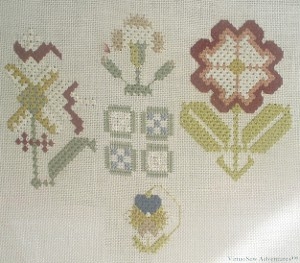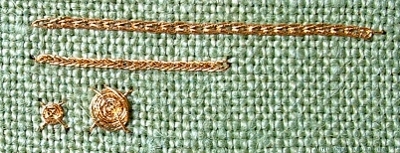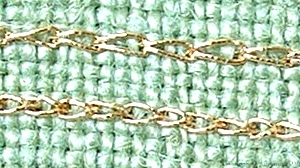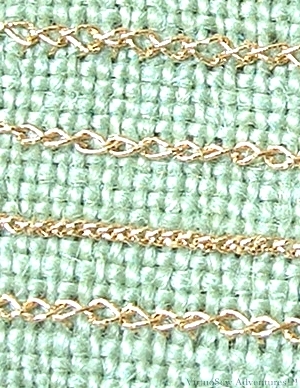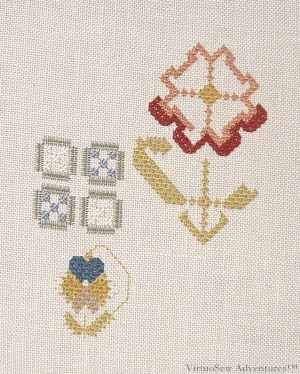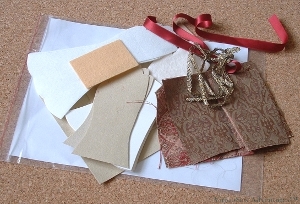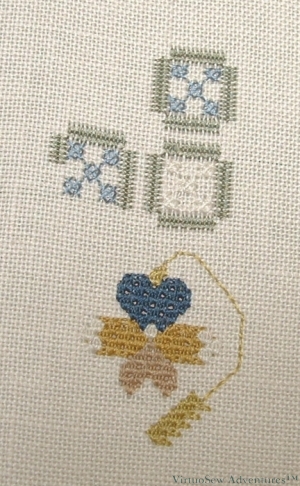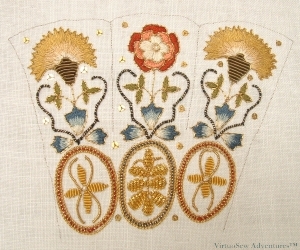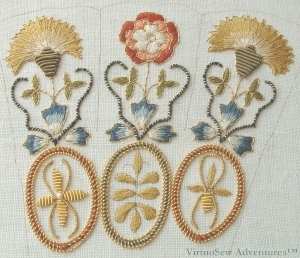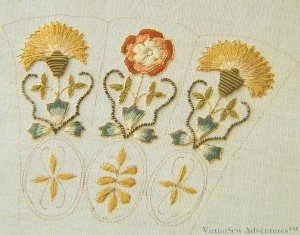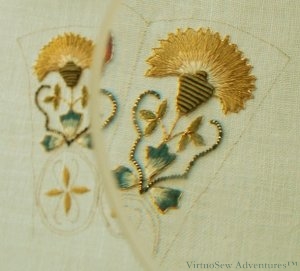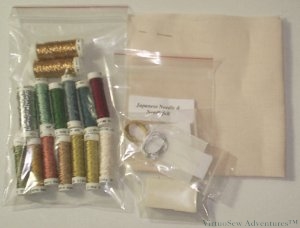Tag: online university
Tudor and Stuart Goldwork Master Class – Progress on the Silkwork
I’m still working away at the silkwork on the sampler. It has been so grey and miserable recently that the light has been poor and it has been difficult to make any progress at all.
Some time ago I bought a daylight lamp to use in the evenings or when the natural light is poor. It works well for some projects, but not this one. I think part of the problem is that it glares on both the fabric and the magnifier, and believe me, I’m not going to work this piece without a magnifier!
So I can only work on this when there is good natural light, but not glaring sunshine, of which there has been all too little this summer. I’m also careful not to strain my eyes, so I work maybe two lengths each time I sit down, but no more.
I’m working one motif at a time, and letting it grow from the nearest point at which it approaches a previously finished one. That means I have relatively little counting to do, although sometimes I start a motif somewhere a little odd. The one I am working on at the moment started from the tip of the large leaf. When I do have to count, I count in fours – that is, the width of one Queen Stitch. I can almost do that by eye, and if I do miscount, it’s easy to double check.
The stitch produces a very pleasing texture on the fabric, and because it is a pulled stitch – at least on this fabric – there is a light and lacy look to it. If only I had better light I would be enjoying this even more!
Tudor and Stuart Goldwork Course – Month Three Practice
I am continuing to work practice lengths and fragments of the stitches in the Goldwork MasterClass, since I am still working the silk motifs that form the basis for the Spot Sampler.
Again I worked the Heavy Chain Stitch in two “scales”. I find it rather surprising that the stitch changes width with the length, even though the needle comes up from and returns into the same hole. Still, it is useful to know that I can change the appearance of scale so much without changing the thread I am using.
The second stitch is Four-Legged Flat Spider Web Stitch, and I’ve not found a diagram on the web anywhere. It is a large cross stitch, woven around in a weaving pattern. Simple to do, if you make sure to go over the top layer of the cross stitch and under the bottom layer. The challenge lies in keeping the thread spiralling smoothly around, rather than catching itself and crossing where it shouldn’t. I think I would be reluctant to use this stitch on a garment or something that would move a lot, as I would be uncertain of the stability of the coil. Using it on my sample cloth might reveal that, of course. I shall try to remember to examine it at the end of the course!
Tudor and Stuart Goldwork Masterclass – the first two Goldwork Stitches
I’ve not come near finishing the silk work on the Spot Sampler, so I am going to do some practising first. The fabric is a heavy plain weave, about 16 threads to the inch. Compared with the linen for the actual piece it is almost like binca! I chose it to give me some chance to see what I was doing and to count the threads if it proved necessary for the stitches. It wasn’t really for the first two, but I did so anyway!
Reverse Chain Stitches
This produces, to all appearances, simple chain stitch, but it doesn’t involve the “scooping” motion used when working in the hand and seems somewhat easier to control.
I’ve done it both over three and over two threads.
Reverse Twisted Chain Stitch
Again, the resulting appearance is of simple twisted chain but the stitch is worked backwards, I think this reduces the chances for the gold thread to snag on itself, which certainly helps.
As shown in the original diagram, it is worked over a grid in effect, of two threads by two. After doing that fairly easily I decided to play a bit.
So I worked several variants, over two by four, two by one, one by one, and two by two.
The one by one was quite a challenge, but I am pleased that I have an impression of the changes in appearance effected by the different stitches.
More on the Masterclass
I’m making progress on the Tudor and Stuart Goldwork Masterclass. As I mentioned, I was a little anxious when I realised how much counted work was involved, but I am developing techniques to cope. Since the designs are large and simple, rather than being full of subtle shading, it is actually fairly easy to decide by eye where the next stitch goes. I count twice to place a new motif correctly, but then just do what seems right.
The other decision I have made is to help convince myself I am making progress – so here, instead of finishing the leaves, I’ve started on the flower. It gives me a better idea of the extent of the design – this is the top right hand corner – and I needed the reassurance!
Megan has produced a fantastic round-up of links and resources about Queen Stitch over at Elmsley Rose – well worth following up, as each different description contributes to developing a technique for working the stitch.
I am planning to set up another frame with a piece of cloth to practice the goldwork stitches on, since some of them will need it, but for the moment I am trying to apply some discipline to my stitchery…!
Floral Glove Needlecase – The Finishing Kit
Another gentle thump through the letterbox and the Finishing Kit for the Floral Glove Needlecase has arrived.
Neatly die-cut pieces of card, interfacing, and fabric, lengths of ribbon and lace… It all looks rather promising, doesn’t it!
The first thing I need to do (I’ve looked at the instructions online but not quite got as far as printing them out) is to embellish the ribbon with gold thread and spangles. I am learning from this project that the layering of intricate detail and embellishment can be hugely successful; even when you think something is as ornate as it needs to be, sometimes it looks better with more.
That doesn’t work with fashion – I remember coming across this some years ago. Even now I survey myself critically in the mirror before going out, to see whether I need to remove an accessory. And this is a link to the picture referred to in the post.
Beginning the Tudor and Stuart Goldwork Masterclass
So now I am beginning to do the silk embroidery for the next Thistle Threads Online University Course, the Tudor and Stuart Goldwork Masterclass.
More gorgeous Au Ver A Soie silk thread to play with!
Furthermore, some new stitches! I’m not keen on counted work, so when I saw a chart in the instructions, my heart sank. Then I read the instructions and realised it was going to be a bit more fun than I had thought…
So, most of the silk stitching is to be in Queen Stitch, which I think I have done in canvaswork before, but never at this scale, and never changing its orientation or doing half queen stitches. The square motifs are bordered in Roman Stitch with Rice Stitch in the middle. Apparently in the historical pieces, Queen Stitches are often treated almost as pulled work, creating a lacy pattern of holes between the stitches. It’s quite difficult to pull tight enough, but as you can see from the navy blue petal, I’m beginning to get the hang of it.
The great attraction of this course for me is that we will have animations to show us the complex gold thread stitches that are the main focus of the course. At the end of the course, we’ll get a CD of these animations, so if I forget how to do one, I will be able to learn it again. Furthermore, some of Tricia’s recent posts on The Embroiderer’s Story mention that she has discovered some new stitches during her research trip and she is hoping to add them as a bonus!
Floral Glove Needlecase Embroidery Finished!
At least I think it must be. I think the next two months involve the finishing process – adding trims and making the needlecase itself.
I’ve finally got the idea of how the purl should work. It needs to be cut fractionally longer than the distance it is to cover, so as to produce a very slight – a very slight! – curve. This results in a slightly less scrappy look, because the ends of the “beads” of purl aren’t so obvious. It’s not easy to cut accurately – at least, I didn’t find it so, but where I got it right, the sections look much better.
Adding the spangles makes a surprising difference to the final effect – they are so tiny and delicate you don’t expect them to make much difference, but the fragile sparkle really enhances the final effect.
I’m not going to go back and redo the bits that aren’t quite perfect. It will be useful to have the reminder of what I should be aiming for beside the reminder of what I should try to avoid! I’m pleased with what I’ve produced and – although it may not be obvious from the photo – I can see that I have improved over the course.
Floral Glove Needlecase – More Progress
It became clear as I was working on the medallions that I was having more trouble with this than I had with the silk work or couching the Elizabethan Twist, so I thought I would give a sort of “interim report”.
The medallions are outlined with three couched rows of slightly stretched purl purl or lizardine, one of which is wrapped with silk. That in itself was fairly hair-raising (it sounds so simple, but believe me, it isn’t!), and yes, I know that the outlines aren’t perfect and you can see the joins, but they did get neater. The man who said “The more I practice the better I get” was onto something!
The tendrils are slightly stretched lizardine again – stretched by a different amount, just to make sure we paid attention! Then the silk of the motifs is covered with couched lengths of purl, like the calyxes of the carnations. It is surprisingly difficult to cut this stuff accurately – the instructions say to use an old pair of embroidery scissors, which I did, but I find myself wondering whether a sharp craft knife would do the job better. Certainly there would be less chance of crushing the thread. Purl is very fine wire, wound spirally around a former, and when the scissors crush it, the ends are bent out of shape and catch on the thread as you try to thread it through. Since purl is attached by threading it like a bead, this isn’t ideal; even waxing the thread only helps some of the time.
It’s astonishing to see the difference made to the medallion on the left when I added the seed pearl in the centre. I thought it looked neat and finished as it was, but adding the pearl brought the whole thing to life. Now there’s a lesson worth remembering – a small change can make a huge difference to the impression given by a piece. At least embroiderers can undo some of their additions. If you add something to a watercolour that turns out to be a mistake, there’s nothing you can do about it!
Still, I do think I am beginning to get the hang of it. Now it will be interesting to see whether I’ve slid all the way back to the start, or whether, when I continue on the next medallion, I retain some of the improvement I made yesterday.
Floral Glove Needlecase – Month Three Finished!
So, making progress here. All the silkwork is outlined in Elizabethan Twist, carefully following the suggested paths so as to have the smallest possible number of ends to sink.
Then the calyxs of the two carnations are covered with Olive smooth purl, cut to size and treated like a bead. This was fairly tricky because it was easy for the end of the purl (which is a very fine wire, coiled up) to catch on the silk thread being used to sew it down. In fact for the second calyx, I waxed the thread, which made the whole experience less fraught! I notice I didn’t quite get all the lengths or maybe spacings right for the first calyx, but for now I shall leave it as it stands.
Then I couched the striped thread curlicues. Again it was tricky to place the black couching thread where it would disappear into the thread being couched, but I think a few tweaks with a needle will fix that!
Finally, I thought I would show what a difference a magnifier makes. As I think I have said before, it is the change in size that terrifies. I began by stitching without a magnifier and was reasonably happy doing so. I just felt that it would be a useful additional tool, especially given some of the other projects I have in mind.
My eyes become accustomed to regarding the magnified view as normal, then when I stop for a cup of tea, I push the magnifier to one side to have a “proper” view. At which point there’s a small squawk and my husband asks what’s wrong. “It’s gone all tiny”, I say, “Don’t tell me I stitched that!”. After the said cup of tea, ordinary views reassert themselves and it doesn’t seem quite so astonishing.
Which is really just as well. We don’t embroider to scare ourselves, after all!
Starting Another Course
I decided to follow another Thistle Threads Online University course. This time it is the Tudor and Stuart Gold Master Class, and my first materials kit arrived today. There is more of that lovely Au Ver A Soie, and a lot of gold thread for practising with, as well as for working on the spot sampler.
The real attraction of this course to me is that Tricia has worked out how some of the ornate and now mysterious stitches of the period would have been worked. The stitches shown on the video look fascinating, and as well as providing instructions, she is providing animations to help her students learn how to work them. First, however, there is the silkwork to do, largely in Queen Stitch, Rice Stitch (a cross stitch variation), and Roman Stitch.
As with the Floral Glove Needlecase, there was a larger number of students enrolling than Tricia expected, and between us we appear to have wiped out the worldwide stocks of some colours in the silk thread. As with all specialist enterprises, the manufacturers tend to expect small orders, and it may take years for a dye lot to be used up. However, we can hope that more people will be introduced to these threads and will begin to use them more. Potentially this will lead to more shops stocking the more unusual materials, and make it easier for us to buy them.
As Shakespeare would have said, “A consummation devoutly to be wished!”

